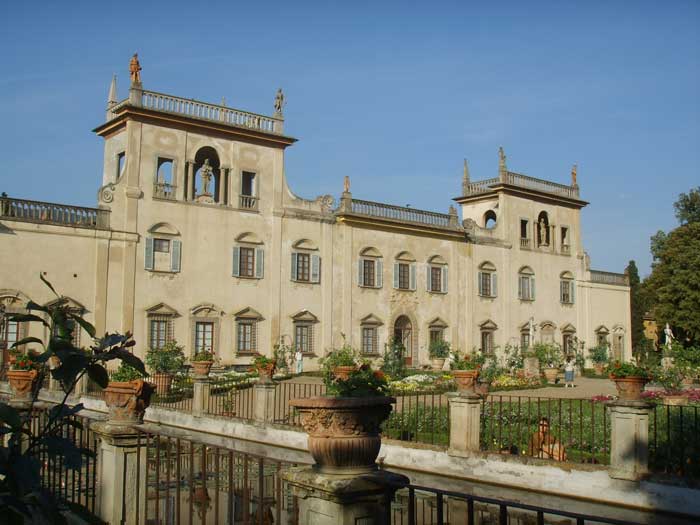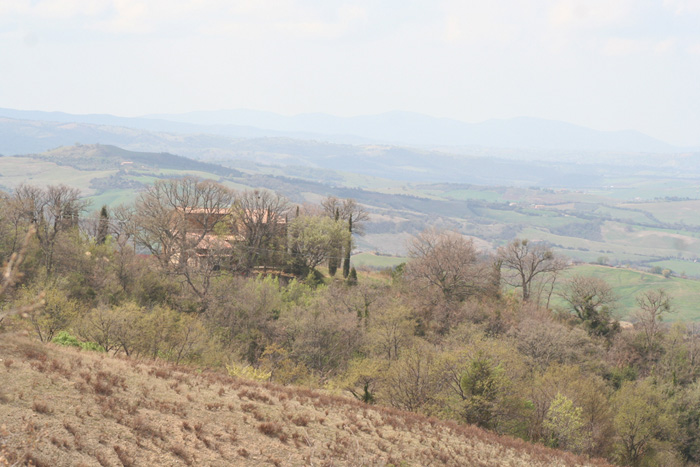 |
| Villa Guicciardini Corsi Salviati in Sesto Fiorentino
|
Villa Guicciardini Corsi Salviati |
| Villa Corsi Salviati is located in Sesto Fiorentino. Sesto, literally "Sixth", is a town about six miles (on "the sixth Roman mile") from downtown Florence. Villa Corsi Salviati is not far from three magnificient villas belonging to The Medicis: Villa di Castello, Villa della Petraia, Villa di Careggi {see map 2}. Sesto Fiorentino developed along a South East—North West diagonal axis of a road (now, respectively, Via Gramsci and Viale Pratese) leading from Florence (SE) to Prato (NW) {see map 3}. Villa Corsi Salviati is located at the very entrance into Sesto when traveling from Florence to Prato. See map showing downtown Sesto - N. 11 encircled in red indicates the building and the enclosed garden space of the Villa. In 1502 Simone di Jacopo Corsi acquired a country property with a "casa da signore", or a noble's house, in Sesto Fiorentino. Frescos which still exist show early 15th-16th C. views painted by Alessandro Fei. These paintings show a dove cote on the roof. Niches on either side of the main door on the garden side contain statues of sitting dogs. The large main door is painted red. In front of the house is a garden, or rather lawn divided into quarters by two paths which form a cross . Around the garden small figures of people are engaged in various activities. Hanging from the roof terrace, or "altana", one can see the laundry fluttering in the breeze {see original house }. The other painting by Fei shows the courtyard, flanked on three sides by an arched loggia. In the center one can see the fountain which at present is surmounted by a statue differing from the original {see courtyard} . Both building and garden underwent several changes during the last four plus centuries. At the end of the XVII century the plan of the Villa and garden looked like this {see XVII cent. plan} Around 1738 Marquis Antonio Corsi began modifications which brought the Villa and garden its present-day look (in restored form). The appearance of such changes were accurately fixed in an very fine hetching produced around 1750 by Giuseppe Zocchi (1711-1767) {see Zocchi's hetching}. There are indications of a "ragnaia", or an area in which a net was spread to catch birds, as early as 1664. The "ragnaia" was a kind of extension , beyond the southern wall, of the "Vasca lunga" which was used as "peschiera" or fish-pond. In the project executed from 1751 to 1752 the nearly 1000 feet long "ragnaia" was brought to its present state, making it one of the most charming ornaments of the Sesto garden. Other changes were executed during the XIX century. Among these, a new direction was undertaken by the construction of greenhouses under Marquis Bardo Corsi Salviati for the cultivation of tropical and rare plants. The rich collection of these plants, in 1866, gave scientific importance to the garden. However, Sesto's once most important botanical garden declined toward the end of the century. In 1907, at the death of Marquis Bardo Corsi Salviati, the Sesto Villa passed into the hands of his grandson, Count Giulio Guicciardini, who began restoration of the villa and undertook the transformation of the garden in order to bring it back to its XVIII century splendor. In 1935 the plan of the Villa, garden and ragnaia looked like this {see plan with "ragnaia"}. The Sesto ragnaia was considered by landscape architects as one of the best ever planned and constructed. Now the ragnaia is under the control of the City of Sesto. Unfortunately, it has been completely neglected and today it is nearly in total squalor {see ragnaia today}. Villa Corsi Salviati Guicciardini at Sesto is still under ownership and control of the Guicciardinis. From January 1986 to the present the major part of the Sesto Villa has been the Seat of the Universities of Wisconsin Michigan and Duke Academic Program in Florence. The Program is administered by The University of Michigan. The former "Limonaia" on the west end of the Villa has been for many years the center of the Teatro della Limonaia. The villa has a late renaissance garden and a nineteenth century romantic garden. |
Address: Villa Guicciardini Corsi Salviati, Sesto Fiorentino, Via Gramsci 462 |
||
Hidden secrets in Tuscany | Holiday house Podere Santa Pia
|
 |
The panoramic position in the Tuscan countryside offers great views.
|
|
| Wikimedia Commons contiene file multimediali su Villa Guicciardini Corsi Salviati |
